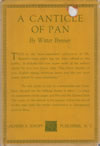
BE. Witter Bynner
 |
3. A Canticle of Pan and Other Poems. New York: Knopf, 1920.
Includes the only Bynner poems definitively traceable to his travels in Japan. Wilbur (24b) notes the influence of Buddhism. †Richard Hageman’s ‘Voices, Medium’ (New York: Galaxy Music, 1941) is a musical adaptation of portions. Reprints Through a Gateway in Japan (2). A-f appear in a ‘Japanese Notes’ section. See also 23.
 |
a. In the House of Lafcadio Hearn (see D9). Bynner was among the few early pilgrims to the Hearn house in Matsue, thirteen years after Hearn’s death, though thousands have followed. Description of circumstances leading to the composition of the poem, and the poem itself, appear in Bynner’s letter of May 1917 to Haniel Long (see 20b). He had made the ‘pilgrimage’ on his own, since he could not interest Ficke in the journey. The poem is ten lines of conventional verse recounting the visit. Bynner’s prose in the letter is considerably more poignant.
b. In the Yoshiwara. Describes in conventional verse a woman in the entertainment quarter of Edo.
c. In a Temple. Description of a fortune, or omikuji, received at a temple: ‘If you work hard all the time, / Good luck will attend you like a steady wind.’
d. In a Theatre. The sound of the wooden blocks struck together to announce the beginning of a kabuki play and the sound of the wooden clogs striking the floor as the actor enters become a metaphor for the speaker’s anticipation: he hears them ‘Clacking through the night to my door, / For the curtain of my heart to rise / On my own actor, / My beloved’.
e. In a Poem. Describes an old woman who ‘dusted the paper shutter / Very carefully’ so that ‘the shadow of the pine-tree / Might be quite perfect’.
f. In a Painting. The speaker has guided a ‘you’ up an ‘infinite mountain . . . made of skulls’. The reference would be to one of several Japanese and Chinese Buddhist works that depict such a mountain.
 |
g. In Kamakura. Bynner’s most striking poem on a Japanese subject recounts reactions to the Great Buddha of Kamakura and anticipates by decades a turn in American poetry toward identification with Buddhism. The speaker contemplates two images of the Buddha and loses himself in both. In the latter the figure, bought at a souvenir stall, has ‘. . . a steel of a round mirror for His halo . . . // So that a brooding head still intervenes in bronze / Between my face and the image of my face, / And I cannot see myself and not see Him.’ Reprinted in 17 and 21. See also 24b.
h. The Neighbors Help Him Build His House. Identified as ‘a Japanese Folk-Chant’. ‘Songs’ of a young man, an old man, and ‘others’, about the blessings of spring and of the Buddha. .

